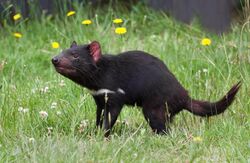Biology:Sarcophilus laniarius
| Sarcophilus laniarius Temporal range: Late Pleistocene
| |
|---|---|

| |
| Scientific classification | |
| Domain: | Eukaryota |
| Kingdom: | Animalia |
| Phylum: | Chordata |
| Class: | Mammalia |
| Infraclass: | Marsupialia |
| Order: | Dasyuromorphia |
| Family: | Dasyuridae |
| Genus: | Sarcophilus |
| Species: | †S. laniarius
|
| Binomial name | |
| †Sarcophilus laniarius (Owen, 1838)
| |
| Synonyms | |
| |
Sarcophilus laniarius is an extinct species of large Tasmanian devil. Richard Owen originally called the specimen on which the genus was based Dasyurus laniarus.[1]
Pleistocene fossil deposits in limestone caves at Naracoorte, South Australia include specimens of S. laniarius, which were around 15% larger and 50% heavier than modern devils.[2] Older specimens believed to be 50–70,000 years old were found in Darling Downs in Queensland and in Western Australia.[3] It is not clear whether the modern devil evolved from S. laniarius, or whether they coexisted at the time.[3] Richard Owen argued for the latter hypothesis in the 19th century based on fossils found in 1877 in New South Wales.[3] It has been conjectured that S. laniarius and S. moornaensis, another now-extinct larger species, may have hunted and scavenged.[3] It is known that there were several genera and species of thylacine millions of years ago, and that they ranged in size, the smaller being more reliant on foraging.[4] As the devil and thylacine are similar, the extinction of the co-existing thylacine species has been cited as evidence for an analogous history for the devils.[5] It has been speculated that the smaller size of S. laniarius and S. moornaensis allowed them to adapt to the changing conditions more effectively and survive longer than the corresponding thylacines.[5]
As the extinction of these two species came at a similar time to human habitation of Australia, hunting by humans, as well as land clearing, have been mooted as possible causes.[6] Critics of this theory point out that as indigenous Australians only developed boomerangs and spears for hunting around 10,000 years ago, a critical fall in numbers due to systemic hunting is unlikely. They also point out that caves inhabited by Aboriginal people have a low proportion of bones and rock paintings of devils, and that this is an indication that it was not a large part of indigenous lifestyle. A scientific report in 1910 claimed that Aboriginal people preferred the meat of herbivores rather than carnivores.[7] The other main theory for the extinction was due to the climate change brought on by the most recent Ice Age.[6]
References
- ↑ "Archived copy". Archived from the original on 2012-03-24. https://web.archive.org/web/20120324051524/http://palaeontology.palass-pubs.org/pdf/Vol%206/Pages%20615-624.pdf. Retrieved 2011-07-01.
- ↑ Owen and Pemberton, p. 35.
- ↑ 3.0 3.1 3.2 3.3 Owen and Pemberton, p. 36.
- ↑ Owen and Pemberton, p. 37.
- ↑ 5.0 5.1 Owen and Pemberton, p. 38.
- ↑ 6.0 6.1 Owen and Pemberton, p. 39.
- ↑ Owen and Pemberton, pp. 40–42.
- Owen, David; Pemberton, David (2005). Tasmanian Devil: A unique and threatened animal. Crows Nest, New South Wales: Allen & Unwin. ISBN 978-1-74114-368-3. https://archive.org/details/tasmaniandevilun00owen_0. Retrieved 22 August 2010.
Wikidata ☰ Q194609 entry
 |

